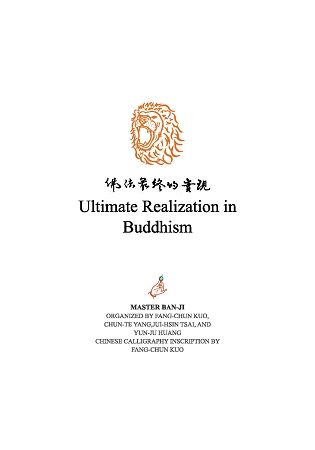Europeans have generally interpreted Nagarjuna's MU/amadhyamakakarika from the perspective of Aristotle's law of excluded middle. Indian religions tend to describe the world as full of suffering, and prescribe spiritual discipline as the way to escape from it; this is why Indian religious teachings heavily rely on negation. Examples in the Buddhist tradition include the eighth verse of the MU/amadhyamakakarika, which states, "Everything is real, not real, both real and not real, neither real nor not real; this is the teaching of the Buddha"; the sphere of neither perception nor non-perception(Bhavagra); and the passage in the Diamond Sutra which reads, ''No notion of self; no notion of person; no notion of sentient being; no notion of life span." Such negations are typical of Indian religious discourse, and indicate that negation of the world is its fundamental approach to spiritual cultivation; whether or not this is correct is another issue altogether.
I’m not a scholar with a penchant for splitting hairs; my main concern is with presenting a correct understanding of Buddhist doctrine, so that it can serve as a reliable guide to actual practice. For example, when Buddhism first came to China, the Daoist term wu~ was used to translate the Sanskrit term siinyatii, yet such borrowing has caused a lot of confusion that still needs to be corrected, lest one’s practice come to naught.
Thus the primary motivation for this translation is to serve as a guide to Buddhist practice.
| FindBook |
|
有 1 項符合
ultimate realization in buddhism的圖書 |
 |
$ 288 | Ultimate Realization in Buddhism佛法最終的實現【金石堂、博客來熱銷】
作者:Master Ban-Ji 出版社:睿歐廣告社 出版日期:2018-10-04 語言:英文 規格:196頁/15*21cmcm  共 3 筆 → 查價格、看圖書介紹 共 3 筆 → 查價格、看圖書介紹
|
|
|
圖書介紹 - 資料來源:博客來 評分:
圖書名稱:Ultimate Realization in Buddhism
內容簡介
作者介紹
作者簡介
Master Ban-Ji
Master Ban Ji took the tonsure to become a nun at age 19 in 1983. After participating Buddhist activities at Buddhist temples shortly, she devoted the rest of her time immersed in the study of Buddhism and Buddhist practice.
半寄 Ban Ji
半寄,1983年走上流浪之路,時年十九歲,專心研究佛學三十年…。
主要著作有:《修行的探討》、《悉達多的流浪故事》、《糾纏》、《佛法的最終實現》等。
Master Ban-Ji
Master Ban Ji took the tonsure to become a nun at age 19 in 1983. After participating Buddhist activities at Buddhist temples shortly, she devoted the rest of her time immersed in the study of Buddhism and Buddhist practice.
半寄 Ban Ji
半寄,1983年走上流浪之路,時年十九歲,專心研究佛學三十年…。
主要著作有:《修行的探討》、《悉達多的流浪故事》、《糾纏》、《佛法的最終實現》等。
目錄
Preface
Chapter 1 Searching For a First Cause
Chapter 2 The Transformation of Buddhism
Chapter 3 The Transformation of Buddhism and Entering the Way
Chapter 4 Buddha-nature and Human Nature in the Buddhadharma
Chapter 5 The Eight Absorptionsns, Part1
The Eight Absorptionsns, Part2
The Eight Absorptionsns, Part3
Chapter 6 Liberation through Concerntration and Widsom
Chapter 7 The Role of Individual human Nature in Buddhist Practice
Chapter 8 The Sage’s Line of Thought, Part1
The Sage’s Line of Thought, Part2
Chapter 9 The Buddha’s Liberation by Wisdom
Chapter 1 Searching For a First Cause
Chapter 2 The Transformation of Buddhism
Chapter 3 The Transformation of Buddhism and Entering the Way
Chapter 4 Buddha-nature and Human Nature in the Buddhadharma
Chapter 5 The Eight Absorptionsns, Part1
The Eight Absorptionsns, Part2
The Eight Absorptionsns, Part3
Chapter 6 Liberation through Concerntration and Widsom
Chapter 7 The Role of Individual human Nature in Buddhist Practice
Chapter 8 The Sage’s Line of Thought, Part1
The Sage’s Line of Thought, Part2
Chapter 9 The Buddha’s Liberation by Wisdom
序
序
The book was born of my extreme exasperation with meaningless disputations in Buddhism, which led me to spend the past three decades immersed in the study of Buddhism.
It’s a lot like drunken boxing; once you are adept at it, there’s no waking up from it, so all you can do is let birth and death take its course! Be that as it may, one can never live completely cut off from society, so I’ve decided to publish this book in the hope that it will be of benefit to others and will generate some discussion and useful feedback.
Inasmuch as interaction with others is part and parcel of the bodhisattva path, I take people as the central concern of Buddhist practice; thus the underlying motivation in writing this book is to share with others my understanding of Buddhism, in the hope that it will stimulate some new perspectives on the teachings of the Buddha.
Ban Ji
Nan Zen Hermitage
The book was born of my extreme exasperation with meaningless disputations in Buddhism, which led me to spend the past three decades immersed in the study of Buddhism.
It’s a lot like drunken boxing; once you are adept at it, there’s no waking up from it, so all you can do is let birth and death take its course! Be that as it may, one can never live completely cut off from society, so I’ve decided to publish this book in the hope that it will be of benefit to others and will generate some discussion and useful feedback.
Inasmuch as interaction with others is part and parcel of the bodhisattva path, I take people as the central concern of Buddhist practice; thus the underlying motivation in writing this book is to share with others my understanding of Buddhism, in the hope that it will stimulate some new perspectives on the teachings of the Buddha.
Ban Ji
Nan Zen Hermitage
|











